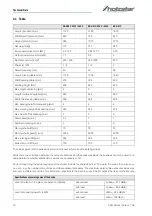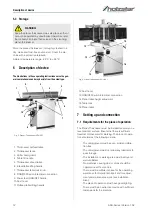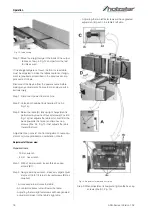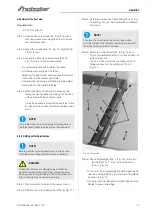
6
ADH-Series | Version 1.02
Safety
2.5 Safety labels on the Planer-Thicknesser
The following safety labels and instructions are attached
to the Planer-Thicknesser s (Fig. 1) and must be
observed.
Fig. 1: Safety labels
1 Warning of danger | 2 Warning of dangerous electrical
voltage | 3 Warning of hand injuries | 4 Warning of danger of
entanglement I 5 Ground symbol | 6 Mandatory signs
If safety labels on the machine are damaged or missing,
this can cause errors, personal injury and material
damage. The safety symbols attached to the machine
must not be removed. Damaged safety symbols must
be replaced immediately.
As soon as the signs are not clearly visible and compre-
hensible at first glance, the machine must be stopped
until new signs have been attached.
2.6 For your own safety
The European standards must be observed when instal-
ling, operating, maintaining and repairing the planer-
thicknesser. For the European standards not yet trans-
posed into the respective national law, the still valid
country-specific regulations must be applied.
Operators of planer-thicknesser outside the scope of
the European Standards are obliged to comply with the
safety and accident prevention regulations applicable in
the country of operation. If necessary, appropriate mea-
sures must be taken to comply with the country-specific
regulations before the planer-thicknesser is put into
operation.
Safety during operation
Before using the planer-thicknesser, make sure that the
following is true
- there is no danger to persons.
- no things are damaged.
- do not work in any way that could compromise
safety.
- use personal protective equipment such as a dust
mask, ear protection, protective goggles.
- The residual hazards listed below basically exist on
planer-thicknessers and cannot be completely
averted by safety devices.
2
3
1
4
5
6
WARNING!
- A planer-thicknesser is a dangerous machine that
can cause serious injury if left unattended. It is the-
refore essential that you follow the following safety
instructions:
- The planer-thicknesser may only be put into opera-
tion and operated by persons who are familiar with
the planer-thicknesser and are aware of the dan-
gers involved in working with the planer.
- Persons under 18 years of age may only use the
planer-thicknesser within the scope of a vocational
training and under the supervision of a trainer.
WARNING!
Always disconnect the planer-thicknesser from the
electrical power supply when carrying out adjust-
ment, inspection, cleaning or maintenance work.
DANGER!
Do not use your fingers to look for end position swit-
ches in order to be able to switch on the planer-thic-
knesser in a way other than intended.
Summary of Contents for 5904026
Page 57: ...Notes ADH Series Version 1 02 57 15 Notes ...
Page 58: ...www holzstar de ...







































